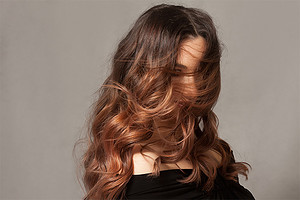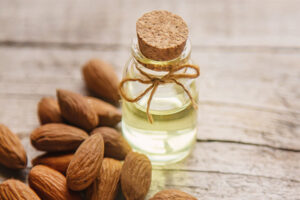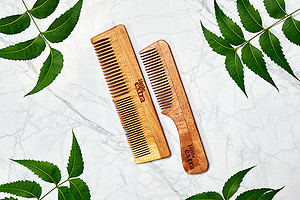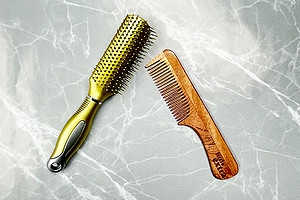Peppermint oil comes from peppermint trees that are native to Europe and is regarded as an excellent agent for hair growth. Menthol, the main component of peppermint oil, is primarily responsible for its beneficial effects. (1)
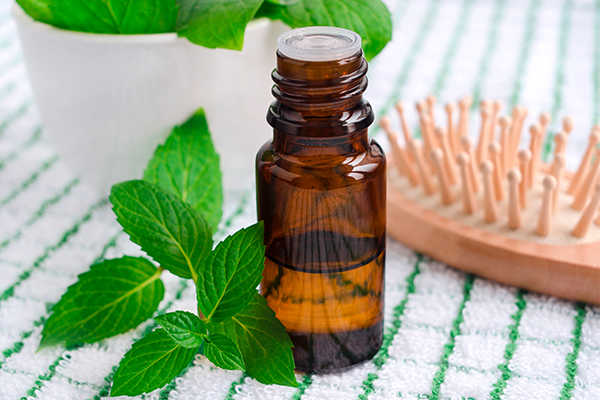
This essential oil is a fragrance and cooling agent and has many uses in skin and hair care. If you wish to explore peppermint oil’s benefits for hair, read on.
Article Contents
Benefits of Peppermint Oil for Hair
Incorporating peppermint oil in your hair care regimen can impart the following benefits:
1. Improves hair growth
A research study has shown that peppermint oil solution was more effective for hair growth than minoxidil. The menthol in peppermint oil stimulates hair growth as it causes vasodilation of the blood vessels. (1)
Another study was conducted on mice, where minoxidil was used in comparison with peppermint oil to evaluate its effects on hair growth. It concluded that both led to similar results in hair growth and thickness. (1)
2. Increases hair thickness
Peppermint essential oil helps increase blood circulation in the scalp, thus stimulating the hair follicles, which results in thicker hair growth, higher follicle numbers, and increased follicle depth. (2)
3. Reduces inflammation
Peppermint has a cooling effect on the skin when applied topically, which helps to reduce skin inflammation.
Research studies have found that peppermint oil has anti-inflammatory and anti-allergenic actions that can help your scalp relax and cool down. (3)
4. Fights infections
Due to its antimicrobial properties, peppermint essential oil helps keep the scalp and hair free from bacteria and fungus. (4)
A clean and healthy scalp is required for the excellent growth of hair. (5)
How to Use Peppermint Oil on Hair
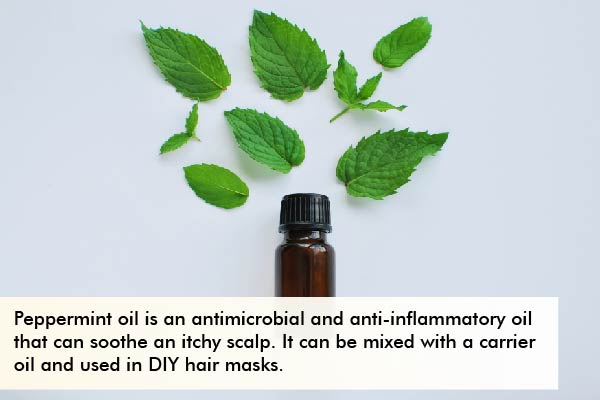
Peppermint oil can be mixed with a carrier oil and used in DIY hair masks. Use it as a pre-shampoo, scalp, and deep-treatment mask to get thick hair growth.
1. Soothing scalp treatment – peppermint oil + jojoba oil + castor oil
Peppermint oil is an antimicrobial and anti-inflammatory oil that can soothe an itchy scalp. (1)
Use it with jojoba oil, which has antimicrobial, antioxidant, and antipsoriatic actions for the skin and is known for inducing hair growth. (6) Combining it with castor oil, which has been used for ages for hair growth, will result in an excellent scalp and hair treatment. (2)
Ingredients:
- 4–5 drops of peppermint oil
- 2 tablespoons of castor oil
- 1 teaspoon of jojoba oil
Method:
- Mix all the oils in a bowl.
- Apply the mixture to your scalp for 5–10 minutes.
- Massage well in circular motions.
- Let it sit in the hair for 40 minutes before washing it off.
- Wash your hair with a natural shampoo and conditioner.
2. Preshampoo treatment – peppermint oil + olive oil + jojoba oil + lavender oil
A preshampoo treatment involving peppermint oil, (1) lavender essential oil, (7) olive oil, (8) and jojoba oil (6) will ensure that your tresses are pampered and well moisturized.
In addition, peppermint oil helps in hair growth, olive oil helps nourish the hair, (8) jojoba oil has antimicrobial properties that keep the scalp clean, (6) and lavender oil supports hair development. (7)
Ingredients:
- 2 drops of peppermint oil
- 3 tablespoons of olive oil
- 3 tablespoons of jojoba oil
- 2 drops of lavender essential oil
Method:
- Mix all the ingredients in a small bowl.
- Wet your hair slightly and apply the mixture to your scalp and hair.
- Let it sit for 40 minutes.
- Rinse it off with a natural shampoo and conditioner.
3. Hair growth serum – peppermint oil + coconut oil
If you want increased hair growth, adding a few drops of peppermint essential oil to your hair oil can help.
Menthol is the key ingredient in peppermint essential oil, a vasodilator that can stimulate blood flow to the scalp, resulting in better and thicker hair growth.
In addition, coconut oil penetrates the hair the most compared with other oils such as mineral oil. (9)
Ingredients:
- 2–3 drops of peppermint oil
- 4–5 tablespoons of coconut oil
Method:
- Mix the ingredients well in a bowl.
- Apply to the scalp and hair.
- Massage well in circular motions for 10 minutes.
- Rinse off after 40 minutes with a natural shampoo and conditioner.
4. Exfoliating scrub – peppermint oil + sugar + coconut oil
Just like your skin, your scalp must be kept clean and healthy through exfoliation. This practice is vital as it can help unclog pores and improve hair growth.
Ingredients:
- 2 drops of peppermint oil
- 2 tablespoons of sugar
- 1 tablespoon of coconut oil
Method:
- Mix all the ingredients in a bowl.
- Wet your hair and scalp.
- Gently massage the mixture on your wet scalp for a few minutes.
- Wash it off with natural shampoo and conditioner.
5. Conditioning hair mask – peppermint oil + avocado + olive oil
Hair masks are great for nourishing and softening the hair. (1)
Peppermint oil is a hair growth-boosting oil and olive oil is a moisturizing one, (8) whereas an avocado provides nourishment through its high fatty acid profile that includes linoleic acid (48.77%) and linolenic acid (12.17%). (10)
Combining these three ingredients in a hair mask can be immensely beneficial for your hair and can help you achieve your hair goals.
Ingredients:
- 5 drops of peppermint oil
- Half an avocado
- ½ cup of olive oil
Method:
- Mash the avocado with the oils in a bowl.
- Apply the mask to your hair and scalp.
- Leave it on for 20 minutes.
- Wash it off with a natural shampoo and conditioner.
Precautions to Take When Applying Peppermint Oil to Hair
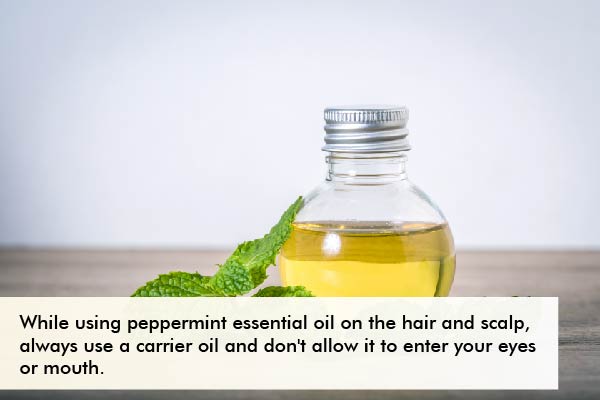
When using peppermint essential oil on your hair and scalp, keep these two key points in mind:
- Always use a carrier oil with it – Applying peppermint essential oil directly to your skin can cause rashes or irritation, so you should use it along with a carrier oil.
- Don’t allow it to enter your eyes or mouth – When applying peppermint oil to your scalp and hair, ensure it doesn’t enter your eyes and mouth as it can lead to burning or irritation. If it does, wash it off with lots of water.
Final Word
Try peppermint essential oil to increase your hair growth, but do so by using it with a carrier oil and only after conducting a patch test on your skin to check for allergies.
References
- Oh JY, Park MA, Kim YC. Peppermint oil promotes hair growth without toxic signs. Toxicological research. https://www.ncbi.nlm.nih.gov/pmc/articles/PMC4289931/. Published December 2014.
- Ezekwe N, King M, Hollinger JC. The use of natural ingredients in the treatment of alopecias with an emphasis on central centrifugal cicatricial alopecia: A systematic review. The Journal of clinical and aesthetic dermatology. https://www.ncbi.nlm.nih.gov/pmc/articles/PMC7595365/. Published August 2020.
- SE; HEJ. Mentha piperita (peppermint). Dermatitis : contact, atopic, occupational, drug. https://pubmed.ncbi.nlm.nih.gov/21144345/.
- Oh JY, Park MA, Kim YC. Peppermint oil promotes hair growth without toxic signs. Toxicological research. https://www.ncbi.nlm.nih.gov/pmc/articles/PMC4289931/. Published December 2014.
- Trüeb RM, Henry JP, Davis MG, Schwartz JR. Scalp condition impacts hair growth and retention via oxidative stress. International journal of trichology. https://www.ncbi.nlm.nih.gov/pmc/articles/PMC6369642/. Published 2018.
- Gad HA, Roberts A, Hamzi SH, et al. Jojoba oil: An updated comprehensive review on Chemistry, pharmaceutical uses, and toxicity. Polymers. https://www.ncbi.nlm.nih.gov/pmc/articles/PMC8197201/. Published May 24, 2021.
- Lee BH, Lee JS, Kim YC. Hair growth-promoting effects of lavender oil in C57BL/6 mice. Toxicological research. https://www.ncbi.nlm.nih.gov/pmc/articles/PMC4843973/. Published April 2016.
- Tong T, Kim N, Park T. Topical application of Oleuropein induces anagen hair growth in telogen mouse skin. PloS one. https://www.ncbi.nlm.nih.gov/pmc/articles/PMC4462586/. Published June 10, 2015.
- RB; RASM. Effect of mineral oil, sunflower oil, and coconut oil on prevention of hair damage. Journal of cosmetic science. https://pubmed.ncbi.nlm.nih.gov/12715094/.
- Flores M, Saravia C, Vergara CE, Avila F, Valdés H, Ortiz-Viedma J. Avocado oil: Characteristics, properties, and applications. Molecules (Basel, Switzerland). https://www.ncbi.nlm.nih.gov/pmc/articles/PMC6600360/. Published June 10, 2019.



